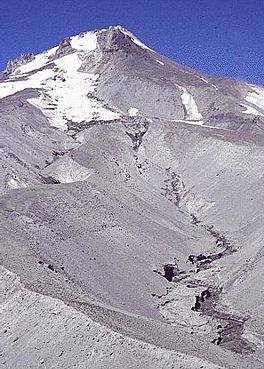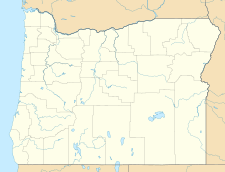White River Glacier (Oregon) facts for kids
Quick facts for kids White River Glacier |
|
|---|---|

The glacier melting in late summer
|
|
| Type | Mountain glacier |
| Location | Hood River County, Oregon, United States |
| Coordinates | 45°21′26″N 121°41′55″W / 45.35722°N 121.69861°W |
| Area | 101 acres (41 ha) (2004 estimate) |
| Terminus | Ice fall |
| Status | Retreating |
The White River Glacier is a large glacier found on the south side of Mount Hood in Oregon, USA. It stretches from about 10,000 feet (3,048 meters) high down to 6,200 feet (1,890 meters). It is one of the most famous of the twelve glaciers on Mount Hood. Many people enjoy Nordic skiing on its lower parts.
This glacier is also where the White River begins. This river flows into the Deschutes River. Sometimes, the glacier causes the river to swell and wash out the bridge on Oregon Route 35.
How the Glacier Formed
The White River Glacier is a leftover from the last ice age. During that time, huge glaciers shaped the land, creating the White River Canyon. This canyon is easy to see from the Timberline Lodge ski area and Mount Hood Meadows.
The glacier has natural borders. On its east side, it shares a ridge with the Newton Clark Glacier. On its west side, it shares a ridge with the Palmer Glacier. The top part of the glacier forms near a rocky area called Steel Cliff. Most of the glacier is inside the Mount Hood Wilderness area.
Glacier Changes Over Time
Sometimes, a lot of water can suddenly burst out from under the White River Glacier. These events are called Jökulhlaups. They happened in 1926, 1931, 1946, 1949, 1959, and 1968. Each time, they washed away Highway 35 or the road that was there before it.
Scientists think that more of these water bursts might be happening because of warmer temperatures. Also, there is a field of steam vents (called fumaroles) near the glacier's top at Crater Rock, which might be growing.
The White River Glacier has gotten much smaller over the years. Between 1907 and 2004, its total area shrank by 61%. The end of the glacier (called the glacier terminus) has also moved back about 1,673 feet (510 meters) during the same time.


